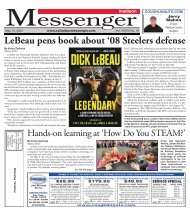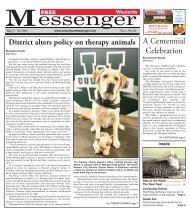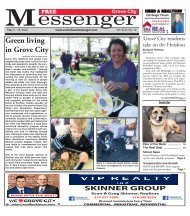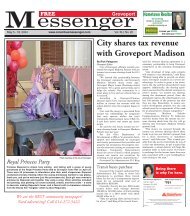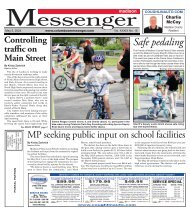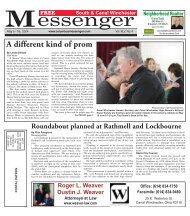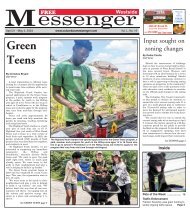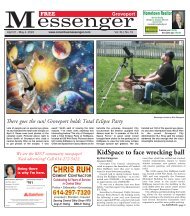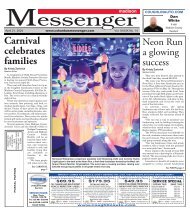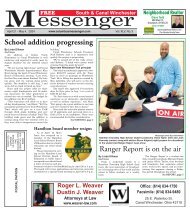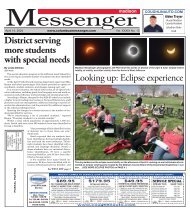Create successful ePaper yourself
Turn your PDF publications into a flip-book with our unique Google optimized e-Paper software.
Pandemic means adapting new ways of teaching and learning<br />
PAGE 8 - GROVEPORT MESSENGER - <strong>December</strong> 20, <strong>2020</strong><br />
By Rick Palsgrove<br />
<strong>Groveport</strong> Editor<br />
In the face of adversity, people often<br />
adapt and rise to the challenge, as<br />
<strong>Groveport</strong> Madison Schools teachers,<br />
administrators, staff, students, and the<br />
community are finding creative ways to<br />
ensure kids get a solid education during<br />
the ongoing coronavirus pandemic.<br />
Because of the recent increase in<br />
COVID-19 cases, the district returned to a<br />
100 percent remote virtual online learning<br />
model in November. School officials anticipate<br />
the district will remain in a 100 percent<br />
online mode until it has been determined<br />
it is safe to a return to in-person<br />
classes, hopefully sometime in 2021.<br />
“When we moved back to the 100 percent<br />
remote learning model on Nov. 16, we<br />
indicated we would closely monitor health<br />
conditions throughout the holidays and<br />
make a determination in mid-January<br />
whether it was safe to resume our blended<br />
learning model,” said <strong>Groveport</strong> Madison<br />
Superintendent Garilee Ogden. “Virtual<br />
online remote instruction is not the most<br />
ideal teaching set up, but we do know right<br />
now it is the safest way to teach.”<br />
Challenges and creativity<br />
Ogden said one challenge for students in<br />
the 100 percent remote learning model is<br />
the limited opportunities for social interactions.<br />
“Our teachers have worked hard to find<br />
creative solutions to address this concern,<br />
but it’s difficult to replicate face-to-face<br />
interactions in a virtual world,” said Ogden,<br />
who added that a challenge for teachers is<br />
providing one-to-one or small group instruction<br />
while also providing whole-group<br />
instruction. “Students don’t always log-in<br />
at designated times for their small group<br />
session, which makes it difficult.”<br />
Ogden said student attendance and<br />
engagement online is high and she is<br />
impressed with the creativity of the teachers.<br />
“Many new teaching tools have been<br />
implemented this year, such as the daily<br />
use of Google Classroom daily, Pear Deck,<br />
Screencastify, and many others,” said<br />
Ogden. “Our hope is that we continue to<br />
use these tools to engage students regardless<br />
of which learning models we’re in at a<br />
given time. We’ve been making many more<br />
home visits and personal communication<br />
with families, which we plan to continue.”<br />
She said the district monitors when students<br />
are not logging in. If there are three<br />
days of no contact, house visits are made to<br />
check on students.<br />
“We want to be sure the kids are okay,”<br />
said Ogden.<br />
Ogden said the teaching and learning<br />
aspects of remote learning are going well,<br />
but the district also makes sure students’<br />
social and physical needs are being met.<br />
She gave the example of an Asbury<br />
Elementary teacher who, noting the kids<br />
are not getting their normal recess time,<br />
created a scavenger hunt that kids can do<br />
at home as a form of having recess.<br />
“The teacher has the kids go through<br />
their homes to find every day items, like an<br />
umbrella or a crayon,” said Ogden. “Kids<br />
need to have time for fun like this and this<br />
is something that can be done safely at<br />
home. Plus it gives parents a break.”<br />
She noted that students needing things<br />
like speech and occupational therapy are<br />
still receiving this help online.<br />
“We are still giving them the support<br />
they need,” said Ogden.<br />
Another example of teacher creativity,<br />
according to Ogden, is the Mail Time video<br />
the high school social studies department<br />
puts together to start the day.<br />
“It’s done like a news show that the kids<br />
can watch where the teachers review the<br />
state standards the kids need to know,”<br />
said Ogden. “Afterwards the students then<br />
log in with their specific teacher.”<br />
She said students in laboratory classes<br />
use live online demonstrations and simulations.<br />
“We also purchased additional software<br />
for our related art teams that assist in<br />
music performance and physical education,”<br />
said Ogden.<br />
She said schools hold morning video<br />
meetings where kids get information and<br />
announcements.<br />
“We’re want to make it like a normal<br />
school day,” said Ogden. “The amount of<br />
creativity and thinking outside the box is<br />
amazing. If you told me eight months ago<br />
we would have to go to 100 percent remote<br />
learning I would’ve questioned it. Now I am<br />
amazed by the collaboration and idea sharing.<br />
It’s gone beyond what was expected a<br />
public school would look like online.”<br />
Cruisers with Chromebooks<br />
Ogden said a big plus for the district<br />
was the support taxpayers provided with<br />
the passage of the operating levy in 2014,<br />
which enabled the <strong>Groveport</strong> Madison<br />
Board of Education to purchase<br />
Chromebook computers for every student.<br />
“Without that we could not have made<br />
such a smooth transition to remote online<br />
learning,” said Ogden. “Other schools had<br />
to wait a long while to get the computers<br />
they needed. We had them already.”<br />
Each student from kindergarten<br />
through 12th grade has their own<br />
Chromebook computer to use for classes.<br />
“We launched our Cruisers with<br />
Chromebooks program in 2017, with middle<br />
and high school students taking their<br />
computers home nightly and over winter<br />
and spring breaks,” said Ogden.<br />
Another plus was a grant obtained by<br />
the district’s technology department to provide<br />
hot spot Wi-Fi capability where needed<br />
for students to allow them online access.<br />
Parents more involved<br />
Ogden said a benefit from the remote<br />
online learning is that parent engagement<br />
has increased from the normal levels found<br />
in the traditional learning model.<br />
www.columbusmessenger.com<br />
“Before the pandemic parents might<br />
have to come to school to talk with teachers<br />
and that was not always possible,” said<br />
Ogden. “Now parents and teachers talk<br />
online at convenient times and work to<br />
support the children. Attendance at parent/teacher<br />
conferences has increased<br />
online. Our relationships with parents are<br />
better than ever. It’s a partnership to be<br />
commended.”<br />
She noted one instance where six district<br />
staff members were able to meet<br />
online with a parent to help a student.<br />
“It was an intimate, quick meeting<br />
where a plan was swiftly put in place to<br />
help the student,” said Ogden.<br />
Students’ ability to adapt<br />
Ogden said remote online learning is not<br />
ideal for all students and that limited faceto-face<br />
interactions with classmates may<br />
have an impact on students’ social awareness<br />
and skills.<br />
“Some kids need to be in school. But we<br />
have to wait until it is safe to do so. We<br />
have worked hard over the past two years<br />
on developing students’ (and adults’)<br />
awareness of themselves and others,” said<br />
Ogden. “We will monitor this area very<br />
closely when we are able to return to inperson<br />
classes.”<br />
When asked if she can see a day in the<br />
future when remote learning will be the<br />
standard form of instruction rather than<br />
using brick and mortar buildings, Ogden<br />
said, “We do see there are students who are<br />
doing exceptionally well and may prefer a<br />
remote learning model for a large percentage<br />
or all of their courses. Anything is possible.<br />
However, we have also seen the negative<br />
impact of 100 percent remote on our<br />
students’ social-emotional learning and<br />
mental health.”<br />
Students’ abilities to adapt to the online<br />
learning model varies.<br />
“It’s not so much about a particular age<br />
group, it’s more about if a student has a<br />
safe, designated learning environment and<br />
an organized routine,” said Ogden.<br />
“Students who are adapting sign in to synchronous<br />
teaching sessions, complete work<br />
independently, and take advantage of<br />
teacher office hours.”<br />
It’s about community and flexibility<br />
Ogden said the community, city of<br />
<strong>Groveport</strong>, and Madison Township have<br />
provided support and ideas to the district.<br />
“Everyone is working together. For<br />
example, the city of <strong>Groveport</strong> gave us<br />
masks,” said Ogden. “Madison Township<br />
gave the district $10,000 to purchase<br />
COVID supplies. It definitely is taking a<br />
village.”<br />
Once the pandemic fades away and<br />
school returns to a traditional model,<br />
Ogden said some of the successful ideas<br />
used during the remote learning model<br />
could be incorporated into teaching in the<br />
future.<br />
“It’s about adapting and being flexible,”<br />
said Ogden. “Thomas Edison once said,<br />
‘When you have exhausted all possibilities,<br />
remember this, you haven’t.’”




